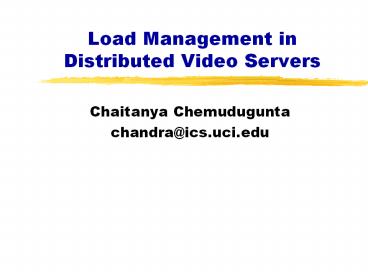Load Management in Distributed Video Servers - PowerPoint PPT Presentation
Title:
Load Management in Distributed Video Servers
Description:
Load Management in Distributed Video Servers Chaitanya Chemudugunta chandra_at_ics.uci.edu – PowerPoint PPT presentation
Number of Views:73
Avg rating:3.0/5.0
Title: Load Management in Distributed Video Servers
1
Load Management in Distributed Video Servers
- Chaitanya Chemudugunta
- chandra_at_ics.uci.edu
2
Load Management in Distributed Video Servers
By Nalini Venkatasubramanian Srinivas Ramanadhan
International Conference on Distributed Computing
Systems (ICDCS 97), May 1997
3
Overview
- Architecture
- Load Management Mechanisms
- Characterizing Server Resource Usage
- Adaptive Scheduling of Video Objects
- Predictive Placement of Video Objects
- Optimization Methods
- Performance Evaluation
4
A Scalable Video Server Architecture
Distribution Network
requests
data
Distribution Controller
Data Source
Data Source
Data Source
Tertiary Storage
...
control
5
Resources in a Video Server
Client
Client
Network
Processing Module
Communication Modules
Data Manipulation Modules
Storage Modules
6
Load Management Mechanisms
- Replication
- When existing copies cannot serve a new request
- Request Migration
- Unsuitable for distributed video servers
explicit tear-down and reestablishment of network
connection. - Dereplication
- Important Storage space is premium
7
Load Placement Scenario
Data Source S2
Data Source S1
Storage 8 objects Bandwidth 3 requests
Storage 2 objects Bandwidth 8 requests
Access Network
...
Clients
8
Characterizing Server Resource Usage
- Ability to service a request on a server depends
on - resource available
- characteristics of a request
- Load factor(LF) for a request
- represents how far a server is from request
admission threshold. - LF (Ri, Sj) max (DBi/DBj , Mi/Mj , CPUi/CPUj ,
Xi/Xj) - Ri Request for Video Object Vi, Sj Data
Source j - DB Disk Bandwidth, M Memory Buffer, CPU CPU
cycles, - X Network Transfer Bandwidth
9
Adaptive Scheduling
- When the distribution controller receives a
request Ri for a video object Vi - Consider only data sources that have a copy of
Vi. - Consider only data sources that have sufficient
resources to support Ri. - Chooser server for which LF (Ri, Sj) is a
minimum. - If no such server exists
- Reject request.
- Perform replication-on-demand.
- Perform request migration.
10
Predictive Placement of Video Objects
- Determines when, where and how many replicas of a
video object. - Initiated periodically.
- Results in an assignment of replicas to data
sources. - Formulated as an optimization problem metric to
be optimized is the total revenue.
11
Predictive Placement of Video Objects Continued
- Each request Ri is associated with a revenue ri.
- ri is dependent on
- Resource required for Ri
- Characteristics of Vi
- Popularity of Vi
- Greedy approach to solve the optimization problem.
12
The Greedy Cost Placement Matrix
PM(Vi, Sj) is the maximum revenue that can accrue
from allocating Vi to Sj.
Greedy heuristic Map(Vi,Sj) 1 if PM(Vi,Sj)
?a ?b max(PM(Va,Sb))
13
Optimizations
- To minimize the overhead of replication
- Eager replication
- Replication of video object in anticipation
- Performed when server resources are free
- Lazy Dereplication
- Critical nature of storage resources
- Mark reusable resources, reclaim disk space later
- If disk blocks are not overwritten, can be
reclaimed
14
Life of a video object
15
Performance Evaluation Policies
16
Performance Evaluation - Startup Latencies
17
Performance of the basic configuration
p1
p2
p3
p4
18
Performance Evaluation - Varying Replication BW
19
Performance Evaluation Summary
- P1 entails high startup latency, requires high
storage and replication bandwidth. - P2 Unacceptably poor performance.
- P3 Similar performance to P4 in many cases.
- At low transfer bandwidths, P4 outperforms P3.
- P4 Performs well in all cases.
20
Thank You

